The n-centre problem of celestial mechanics for large energies
Andreas Knauf
Universität Erlangen-Nünberg, Germany

Abstract
We consider the classical three-dimensional motion in a potential which is the sum of n attracting or repelling Coulombic potentials. Assuming a non-collinear configuration of the n centres, we find a universal behaviour for all energies E above a positive threshold. Whereas for n=1 there are no bounded orbits, and for n=2 there is just one closed orbit, for nS3 the bounded orbits form a Cantor set. We analyze the symbolic dynamics and estimate Hausdorff dimension and topological entropy of this hyperbolic set. Then we set up scattering theory, including symbolic dynamics of the scattering orbits and differential cross section estimates. The theory includes the n-centre problem of celestial mechanics, and prepares for a geometric understanding of a class of restricted n-body problems. To allow for applications in semiclassical molecular scattering, we include an additional smooth (electronic) potential which is arbitrary except its Coulombic decay at infinity. Up to a (optimal) relative error of order 1/E, all estimates are independent of that potential but only depend on the relative positions and strengths of the centres. Finally we show that different, non-universal, phenomena occur for collinear configurations.
Cite this article
Andreas Knauf, The n-centre problem of celestial mechanics for large energies. J. Eur. Math. Soc. 4 (2002), no. 1, pp. 1–114
DOI 10.1007/S100970100037